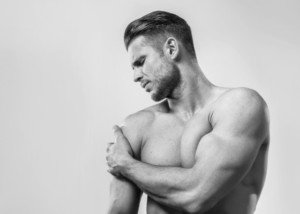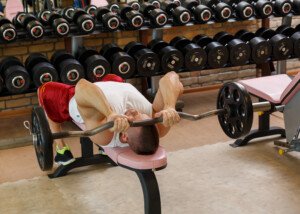Older people who work out at a gym too often underestimate what they can do and thus cheat their bodies from getting much healthier and fitter.
They may fear getting injured or may just have a default assumption that they’re “too old” to do a certain exercise or push a little harder.
Certainly, older people who are new to exercise shouldn’t dive quickly into an intense training regimen, or one that involves jumping or other potentially risky or exceptionally difficult movements such as pull-ups.
The opposite, however, can mean delayed levels of improvement in one’s fitness and strength.
“A lot of my [older] clients think that they aren’t capable of doing certain movements anymore and assume the reason is because they are ‘getting old,’” says Dr. Megan McLain, PT, DPT, cofounder of Intuitive Choice Physical Therapy & Wellness in Atlanta, GA.
“Really, it’s because certain areas have become deconditioned or stiff, and they may not presently be capable of doing a certain action.”
In short: You’ll lose it if you don’t use it.
Dr. McLain continues, “Usually though, we can do a lot more than we think we can.
“We can still build muscle, improve our balance and coordination, and learn new movements even at advanced ages.
“Therefore, it’s important to make sure that you’re continuing to push yourself to try new things in the gym.”
Older People New to Exercise
It’s always a wise idea to get a full health workup to make sure that you don’t have any conditions for which certain forms of exercise are contraindicated.
For example, if you have high blood pressure that doesn’t respond to medication, you’ll want to avoid straining with heavy weights, as this spikes blood pressure.
You should report any finicky joints to your physician. If it’s determined that the recent pains in your knees are from osteoarthritis, then taking up jogging or jumping won’t be a good idea.
What may seem like a risky exercise may actually be one of the safest you can do.
And what may seem like a harmless exercise may bring with it risks for the older, out-of-shape body.
For example, the barbell deadlift may seem impossible – for some interesting reasons.
First of all, use of a barbell can be intimidating to a person with an aged, weak body.
Secondly, it seems as though nearly everyone who does deadlifts at a gym is a much younger, muscled individual, usually a man, and often with a weight load at least twice the weight of the older person’s body.
But the deadlift – a most remarkable exercise for strengthening the back and hips – can be done with an empty bar, which weighs only 45 pounds.
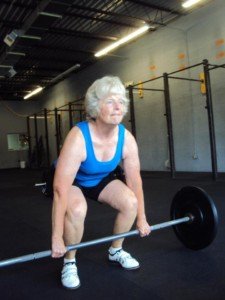
The deadlift. Works the back, core, shoulders, legs and arms.
Though 45 pounds is heavy for a senior age person to push over their head, it’s actually quite doable to deadlift this amount.
People who injure themselves deadlifting are typically young adults with poor form trying to lift a load that’s beyond their capability.
The pushup may seem totally benign for an older, deconditioned body. For starters, you can’t fall or stumble.
Plus, there’s nothing you have to grip and hold onto.
However, an older person with untrained, weak shoulder joints can instantly damage a rotator cuff tendon attempting to do full standard pushups instead of first starting out with their knees on the floor or with their hands against a wall.
Rules of Thumb for Starting Exercise Late in Life
• Learn proper form. Always use correct form. Bad form can cause injuries or greatly slow down progress.
• Strive to lift more weight over time. This is called progressive resistance. But don’t get ahead of yourself and strain with weight too heavy.
• Aim for eight to 12 repetitions per strength training set.
• If you can’t conduct an exercise with good form, the resistance is too heavy.
• Use both free weights and machines.
• Focus on compound rather than isolation exercises. Compound exercises work more than one joint, such as a seated row in which you’re pulling a handle towards your chest.
The biceps curl works only one joint. Compound moves will give you more bang for your buck, and more closely mimic the movements of daily living.
• Unless you hobbled into the gym using a cane, there is no reason why you should hold onto the treadmill – except for momentary security while changing the settings or sipping water.
Below Are Exercises that Older People Will Benefit From

Lat pull-down. Works the back and biceps primarily. Everkinetic, CreativeCommons
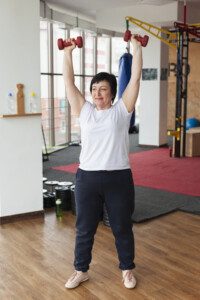
The standing overhead press. Works the shoulders, triceps and low back. Improves balance. Freepik.com
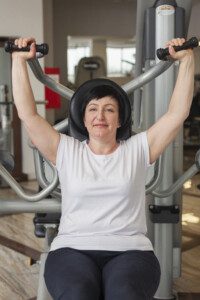
The seated overhead press. Works the shoulders and triceps. Freepik.com
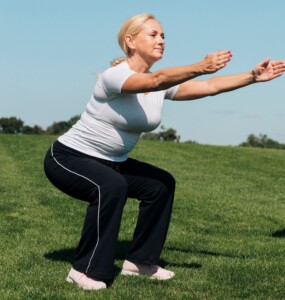
The bodyweight squat. Works the core and lower body. Freepik.com
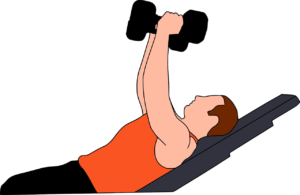
The incline dumbbell press. Works the chest, shoulders and triceps.
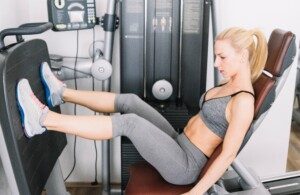
The leg press. Works the lower body. Freepik.com
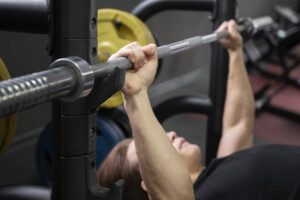
The bench press. Works the chest, triceps and shoulders. Freepik.com
 Dr. Megan McLain, PT, DPT, puts her clients first while providing one-on-one in-home care. With physical therapy and health coaching services, Dr. McLain addresses all aspects such as physical barriers, mindset, accountability and knowledge that may be impacting the client’s experience.
Dr. Megan McLain, PT, DPT, puts her clients first while providing one-on-one in-home care. With physical therapy and health coaching services, Dr. McLain addresses all aspects such as physical barriers, mindset, accountability and knowledge that may be impacting the client’s experience.
 Lorra Garrick has been covering medical, fitness and cybersecurity topics for many years, having written thousands of articles for print magazines and websites, including as a ghostwriter. She’s also a former ACE-certified personal trainer.
Lorra Garrick has been covering medical, fitness and cybersecurity topics for many years, having written thousands of articles for print magazines and websites, including as a ghostwriter. She’s also a former ACE-certified personal trainer.
.


